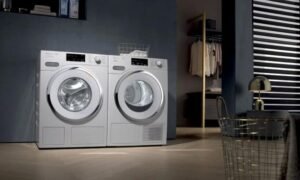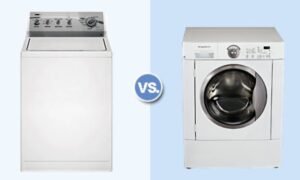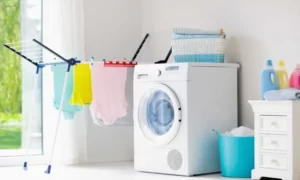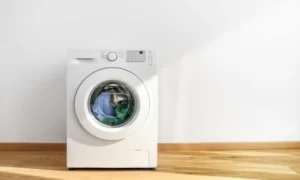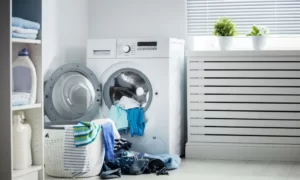Last updated on June 27th, 2023 at 01:24 am
The shape of washing machines is quite important in the appliances of today. These computers’ looks now carry more weight than just basic operation. A well-designed washing machine boosts both its aesthetic appeal and user happiness. In this essay, we’ll examine the significance of washing machine design and examine how aesthetics affect usability and user experience.
The Role of Design in Washing Machines
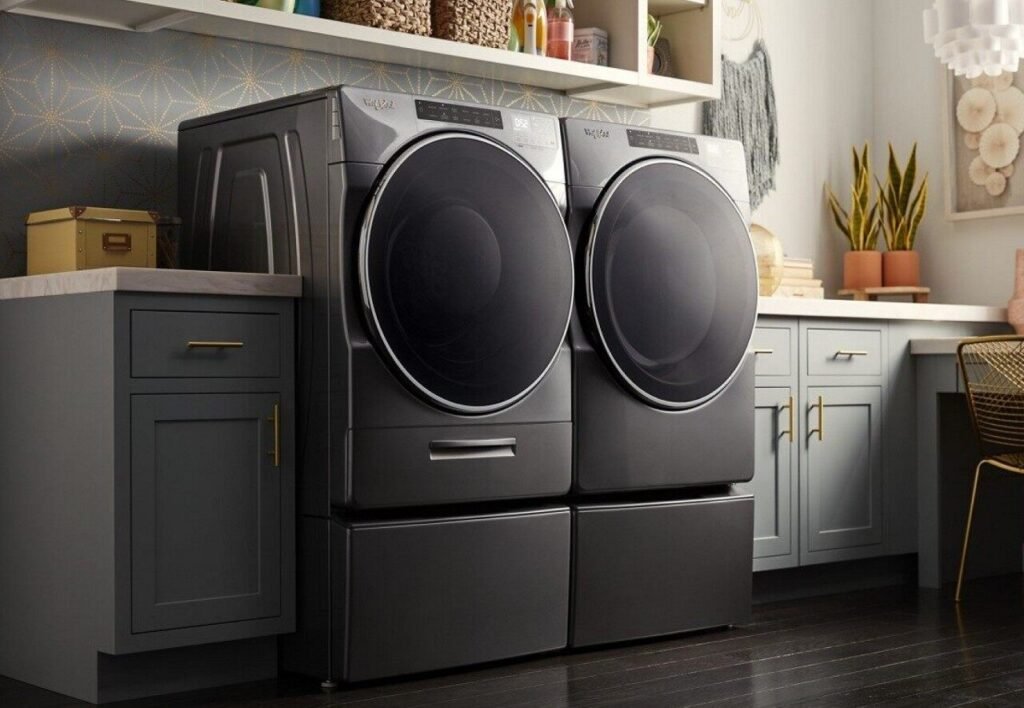
Photo Credit: whirlpool
In washing machines, design has a big impact on the aesthetics, usability, and user experience. Here are some significant elements emphasizing the function of design in washing machines:
Visual Appeal
Washing machines now have more aesthetically pleasing designs that go in well with the decor of contemporary houses. Manufacturers make an investment in producing modern, slick, and fashionable designs that go with many types of home decor. This enables the washing machine to complement the laundry room attractively or, if necessary, even merge into adjacent living areas.
User-Friendly Interfaces
The design of washing machine control panels and user interfaces is essential for delivering a simple and straightforward user experience. Users may choose preferred settings, programs, and choices with ease thanks to clear and simple-to-understand buttons, knobs, and displays. Clear labeling and thoughtful control placement improve user-friendliness and lessen misunderstanding.
Ergonomics
To ensure ergonomic functioning, washing machines‘ physical architecture, and design are crucial. To maximize user comfort and convenience, factors including the machine’s height, the door’s accessibility, and the location of the control panel are taken into mind. A favorable user experience is facilitated by simple loading and unloading of the laundry as well as a clear view of the drum.
Space optimization
Washing machines come in a variety of shapes and sizes to fit different-sized living areas. The design allows for freestanding or built-in installation choices while taking into account space limitations. Larger capacity models serve homes with more laundry demands, while compact washing machines are made for smaller living areas.
Reliability and lifespan
The design of washing machines is essential to guarantee their reliability and lifespan. The durability, high quality, and well-engineered parts of the appliance all contribute to its dependability. The device runs at its peak throughout its career thanks to thoughtful design decisions about load-bearing capacity, drum structure, and suspension mechanisms that assist limit wear and tear.
Noise and Vibration Control
Washing machines with effective noise and vibration control are designed to minimize operational disturbances. Innovative design elements that dampen noise and decrease vibrations during wash and spin cycles include balanced drum systems, anti-vibration technologies, and noise insulation materials. This improves the overall user experience and minimizes disruptions to the environment.
Safety Features
Safety features in washing machines are also taken into account when designing. To shield users from potential risks, the design includes water leakage prevention features, strong door locks, and child lock systems. Users, especially those who have small children or pets, benefit from the piece of mind these safety features offer.
Accessibility and Inclusivity
When washing machines are designed with accessibility in mind, people with mobility issues or other impairments may use the appliance without difficulty. The machine is made more user-friendly by attributes such as a front-loading design, easily placed controls, and possibilities for changeable heights.
Washing machines work to improve both the overall user experience and their functionality and efficiency by introducing smart design aspects. A well-designed washing machine successfully completes its primary task and improves the user’s everyday experience through aesthetics, use, and convenience.
Design Elements in Modern Washing Machines
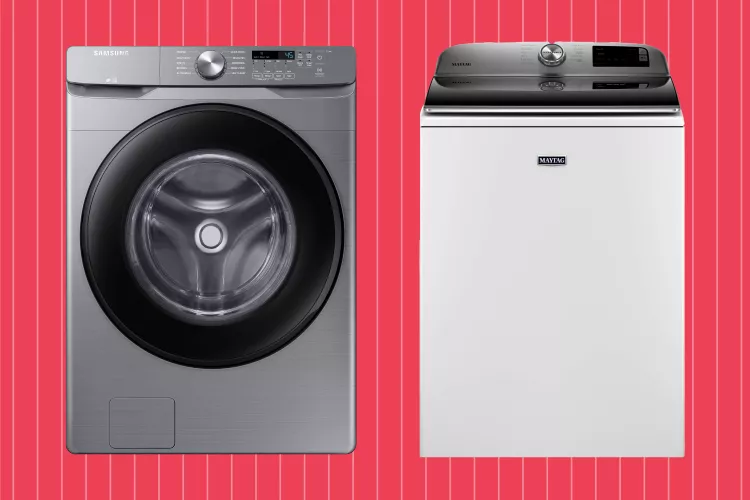
Photo Credit: bhg
Shape and Form
Modern washing machines are available in a wide range of shapes and sizes, providing flexibility and adaptability to various living environments. Compact designs have become more common, meeting the demands of tiny residences and constrained laundry spaces. These space-saving devices offer efficiency without sacrificing style, integrating in beautifully with contemporary home furnishings. Also reflecting current interior design trends, contemporary designs frequently include clean lines and minimalist aesthetics.
Finish and Color
The overall aesthetic impression of washing machines is strongly influenced by the color and finish choices used. To accommodate a variety of consumer tastes, manufacturers provide a broad selection of color choices and finishes. Washing machines now come in a variety of colors to match or stand out in any laundry room, from traditional white and silver to bright red and blue. Homeowners may customize their appliances and develop a consistent design concept for their living area by selecting the color and finish.
Control panel and display design
The usefulness of washing machines has changed dramatically as a result of advancements in display and control panel design. Users enjoy a smooth and participatory experience thanks to intuitive interfaces with touchscreens, LED indications, and customizable settings. These cutting-edge capabilities make it simpler to access extra functionalities, monitor wash cycles, and navigate through numerous settings. The layout of the display and control panel makes it simple and convenient to use a washing machine.
Integration with Surrounding Space
Nowadays, washing machines place a strong emphasis on blending in with the surroundings to create a peaceful living area. The machine may be hidden under cabinets or integrated into pre-existing furniture using built-in and hidden designs. Because of these inventive design decisions, the washing machine maintains a sleek appearance and blends in with the rest of the furniture in the space. Homeowners may keep a consistent design look throughout their living areas with seamless integration.
Washing machine design innovations
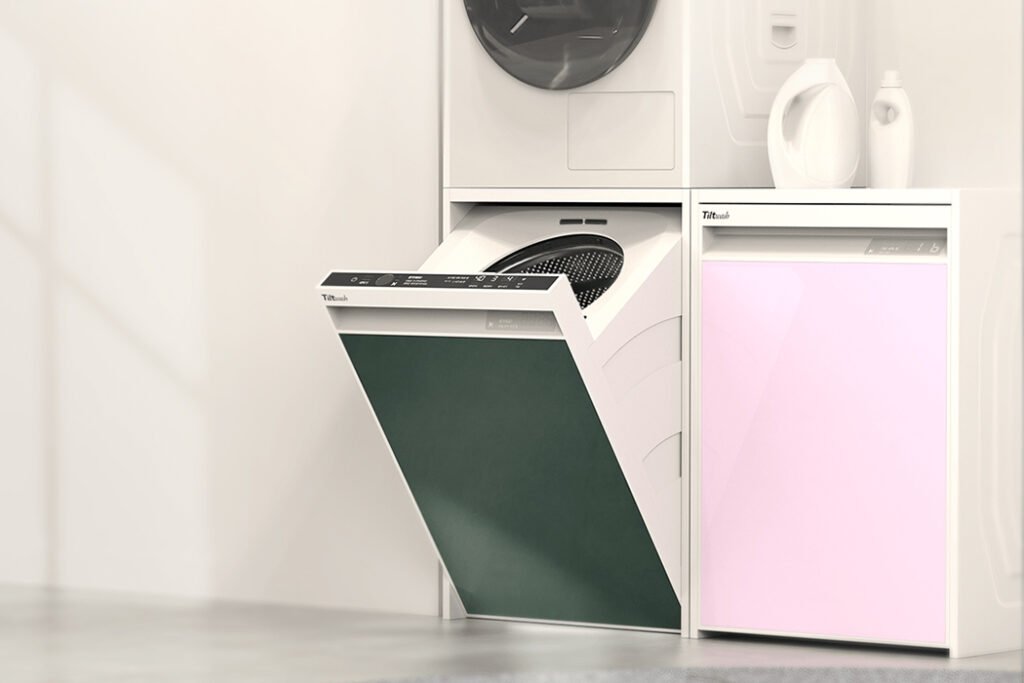
Photo Credit: yankodesign
Vibration and Noise Reduction
The problem of vibration and noise during washing machine operation has been solved through design changes. Modern insulation and anti-vibration technologies provide a calmer washing experience, reducing family disruptions. By putting user comfort first, these products enable people to go about their everyday activities without being disrupted by the noise generated by the washing machine.
Sustainability and Eco-Friendly Design
Designers of washing machines are adding sustainability to their products in response to rising environmental concerns. When designing environmentally friendly products, the goal is to use less water and energy while still performing cleaning tasks effectively. Washing machines have less environmental impact because of energy-efficient parts, water-saving features, and improved wash cycles. Consumers may take an active role in environmental conservation efforts by selecting appliances with sustainably built components.
Smart Design for Enhanced Connectivity
The development of smart home technologies has an impact on washing machine design. The modern characteristics of these appliances enable smooth connection with smart home systems. Users may access and monitor data remotely thanks to Wi-Fi connectivity and app-controlled features. By allowing users to start, pause, or change wash cycles from their smartphones or other connected devices, the smart design improves convenience. The washing process is streamlined and the user experience is enhanced by this degree of control and connectivity.
Conclusion
In conclusion, it is impossible to overestimate the significance of design in contemporary washing machines. User happiness and brand impression are heavily influenced by aesthetics in addition to functionality. Washing machines with thoughtful design incorporate user-friendly elements and ergonomic concerns while improving the aesthetic appeal of living areas. Appliances that easily fit into contemporary lifestyles are created using design features including shape, color, display, and integration. Additionally, advances in sustainability, smart connection, and noise reduction all contribute to a more enjoyable and effective washing experience. Manufacturers and customers should both place a high priority on washing machines that blend usefulness and beauty, turning drudgery into a pleasant experience.
Frequently Asked Question
1. Can a washer’s design effect how well it performs?
-Yes, a washing machine’s performance is greatly influenced by design. A better user experience and effective functioning are made possible by elements including ergonomic design, simple controls, and noise reduction features.
2. Are there any design possibilities for compact laundry rooms?
-Yes, manufacturers sell washing machines with tiny, streamlined designs that are ideal for laundries with little space. These units are perfect for flats or small laundry rooms since they are made to enhance utility while leaving the smallest possible footprint.
3. Can a washing machine’s color and finish affect how long it lasts?
A washing machine’s color and finish have little bearing on how long it will last. But other finishes, like those made of scratch- or smudge-resistant polymers, might prolong the life of the machine by shielding it from damage.
4. Do washing machines have programmable display options?
– Yes, a lot of contemporary washing machines include adjustable display settings. The user experience and convenience are improved by allowing users to customize the brightness, language, and other display aspects to suit their tastes.
5. Can washing machine energy efficiency be increased by smart design elements?
Yes, energy monitoring, load sensing, and adaptive cycle optimization are examples of smart design elements that may significantly increase the energy efficiency of washing machines. With the help of these characteristics, resource utilization is optimized based on load size, which lowers energy use and operational expenses.




